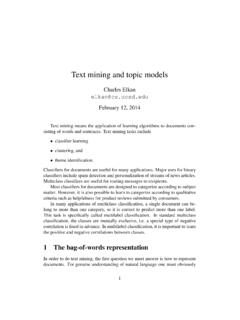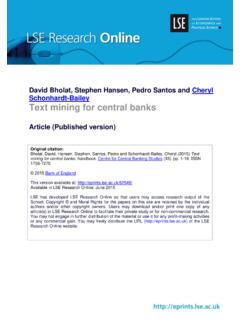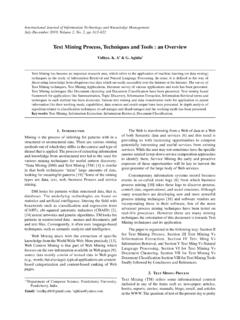Transcription of Complementing the Numbers: A Text Mining Analysis of ...
1 Running Head: Complementing THE NUMBERS: 1 A TEXT Mining Analysis OF COLLEGE COURSE WITHDRAWALS AIR 2011 Forum, Toronto, Ontario, Canada Complementing the Numbers: A Text Mining Analysis of College Course Withdrawals Greg V. Michalski Florida State College at Jacksonville Author Notes Paper presented at the Association for Institutional Research Annual Forum, Toronto, May 24, 2011. Correspondence concerning this paper should be addressed to Greg V. Michalski, Office of Student Analytics and Research, Florida State College at Jacksonville, 501 W. State Street, Jacksonville, FL, e-mail: Complementing THE NUMBERS: 2 A TEXT Mining Analysis OF COLLEGE COURSE WITHDRAWALS AIR 2011 Forum, Toronto, Ontario, Canada Abstract Excessive college course withdrawals are costly to the student and the institution in terms of time to degree completion, available classroom space, and other resources.
2 Although generally well quantified, detailed Analysis of the reasons given by students for course withdrawal is less common. To address this, a text Mining Analysis was performed on open-ended, verbatim, student comments in which students explained their reason(s) for course withdrawal. The text for all comments was extracted from the course withdrawals database of Florida State College at Jacksonville, a large, diverse, multi-campus institution located in northeast Florida. An initial set of 616 comments from the fall 2010 term was used to develop a preliminary text Mining model which categorized of all records. The model was retained and further tested using a second set of 679 comments from the spring 2011 term and found to categorize of the term records.
3 Combined data from both terms (n = 1,295) was used to produce a final text Mining model containing eleven node categories. Model node categories were labeled referencing a framework of prior empirical work in the area of student course withdrawal. Leading academic rationales include course characteristics (especially those involving student preparedness, satisfaction, and delivery mode), faculty satisfaction, and schedule adjustments. Leading non-academic rationales include personal issues especially involving job/work, family, financial, and health. Record classification data from the model were also exported and explored to further group and summarize results. Principal Components Analysis of all data from both terms revealed four components which accounted for 45% of the total variance with the first two components involving instructional delivery and student personal issues accounting for 24% of the variance.
4 Hierarchical Cluster Analysis and Multiple Correspondence Analysis were also used to confirm results suggesting major academic withdrawal reasons to include negative course perceptions and to a lesser degree negative faculty perceptions. Non-academic rationales were found to center on job-work, personal, and time-schedule issues. Limitations and implications for institutional research and practice are presented and discussed. Keywords: text Mining , text Analysis , college course withdrawals, educational data Mining Complementing THE NUMBERS: 3 A TEXT Mining Analysis OF COLLEGE COURSE WITHDRAWALS AIR 2011 Forum, Toronto, Ontario, Canada Complementing the Numbers: A Text Mining Analysis of College Course Withdrawals This paper discusses the use of text Mining to complement more traditional methods typically used to track and analyze student course withdrawals.
5 Many institutions routinely track course withdrawals numerically expressing these numbers in reports as frequencies, ratios, rates, trends, and so on. However, text Mining / Analysis studies of student comments describing precise reasons for course withdrawal are less common. While traditional quantitative descriptive analyses effectively answer who, what, when, where, and how type questions regarding course withdrawals, text Mining focuses on the question of why students withdraw. By combining and integrating both approaches, institutions will be better positioned to take action to improve service to their students. Text Mining is generally considered to be part of the broader field of data Mining (Nisbet, Elder, Elder, & Miner, 2009).
6 The field of data Mining is relatively new and still evolving. Data Mining has been defined in various ways as extracting useful information from large data sets , or the process of exploration and Analysis , by automatic or semi-automatic means, of large quantities of data in order to discover meaningful patterns and rules , or the process of discovering meaningful correlations, patterns and trends by sifting through large amounts of data stored in repositories (Shmueli, Patel, & Bruce, 2010). And while part of this evolution includes specialization in specific disciplines, including education (Romero, Ventura, Pechenizkiy, & Baker, 2011), less attention has been devoted specifically to text Mining . Nevertheless, the growing accessibility of textual knowledge applications and online textual sources has also contributed to an increase in text analytics and text Mining research.
7 Text Mining is a form of qualitative Analysis involving the discovery of new, previously unknown, information extracted and organized from different written sources. In brief, text Mining involves the discovery of useful and previously unknown gems of information from textual document repositories based upon patterns extracted from natural language (Zhang & Segall, 2010). Currently a topic of considerable importance in academia and industry, text Mining theory and practice has also benefited from increased multidisciplinary interest spanning the public and private sectors involving, for Complementing THE NUMBERS: 4 A TEXT Mining Analysis OF COLLEGE COURSE WITHDRAWALS AIR 2011 Forum, Toronto, Ontario, Canada example, multinational government, business and industry, and university research (Berry & Kogan, 2010).
8 While many post-secondary institutions track or otherwise monitor student course withdrawals via quantitative analyses of transactional data, text Mining studies based upon verbatim student comments made at the time of withdrawal remain scarce. Given this a secondary purpose of this paper involves stimulating discourse in this underrepresented area by exploring and extending the use of text Mining to more completely understand college course withdrawals and complement quantitative measures of such. Due to the nature of text Analysis model building and refinement the findings presented and discussed here are probably best viewed more as emerging or developing rather than conclusive or definitive. From an internal institutional perspective further research is required to examine the reliability and stability results over time.
9 This involves the need for further work and fine tuning of the extraction and categorization process which in turn involves the continued development and refinement of linguistic resources, coding, and categorization strategies. Beyond this further progress and additional results, models, and analytic strategies need to be developed and shared between institutions. Literature Review This applied study uses tools, terms, and techniques of text Analysis and text Mining to better understand student rationale for college course withdrawal. This presents the possibility to examine and review briefly (or at least acknowledge) prior work in at least three fundamental and distinct areas involving (1) text Analysis independent of text Mining technology, (2) text Mining and analytics, and (3) prior empirical work in the area of college course withdrawals.
10 Due to current limitations, none of these is treated exhaustively here. The first two areas are related but distinct. The area of text Analysis , independent of Mining technology, acknowledges both the history and well-developed body of knowledge that encompasses the Analysis of text prior to the availability of powerful analytical software and Mining technologies. In the Complementing THE NUMBERS: 5 A TEXT Mining Analysis OF COLLEGE COURSE WITHDRAWALS AIR 2011 Forum, Toronto, Ontario, Canada broadest sense, this can be examined across a wide spectrum of ontological and epistemological frames and lenses with varying emphasis on methods. For example, in studying text Analysis as a guide for research in art education, Ettinger & Maitland-Gholson (1990) acknowledged the work of Geertz (1983) in terms of its influence on social science research.



















